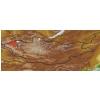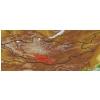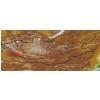| Class: | angiosperms |
| Order: | Gentianales |
| Family: | Rubiaceae |
| Genus: | Galium |
| Scientific name: | Galium boreale L. |
| Name acc. to: | Gubanov 1996 |
| Herbar: | list records   |
| Description: | Stem firm, erect. Leaves linear, by 4 in a whorl, 3-8 mm wide with 3 veins. Flowers white terminal paniculate inflorescence. |
| Link to Flora of China: | http://www.efloras.org/browse.aspx?flora_id=2&name_str=Galium+boreale |
| open map in a new window |  |
| Habitat: | Larch and mixed forests, forest fringes, shrubberies, river banks, foot of rocks (Grubov 2001). |
| Habit (i)general appearance of a plant | |
| Growth form: (i)Herb, shrub, tree or climber. | herb (i)Herbaceous, erect plant, up to 2m high, mostly with a leafy shoot; if perennial, shoots die to the ground each season, shoots are not woody
example: Artemisia pectinata   inherited by family Rubiaceae: herb inherited by family Rubiaceae: herb
|
| Parasite status: (i)Is the plant a half- or full parasite? | no parasite/saprophyte (i)Plant fully autonomous, leaves with chlorophyll
example: Most plants, Ranunculus  inherited by family Rubiaceae: no parasite/saprophyte inherited by family Rubiaceae: no parasite/saprophyte
|
| Water or terrestrial plant: (i)Where do the plants grow? | terrestrial (i)Plant grows on dry land
example: Orostachys spinosa  inherited by family Rubiaceae: terrestrial inherited by family Rubiaceae: terrestrial
water or swamp plant  inherited by genus Galium: water or swamp plant inherited by genus Galium: water or swamp plant
plants in swamps, marshes or bogs, leaves rising above water (i)Semiaquatic; plant terrestrial, but restricted to wet or moistured environments with ground water at or near the surface
example: Phragmites communis  inherited by genus Galium: plants in swamps, marshes or bogs, leaves rising above water inherited by genus Galium: plants in swamps, marshes or bogs, leaves rising above water
|
| Leaf (i)expanded, usually photosynthetic organ of a plant (including phylloclades) | |
| Leaf development: (i)Structure and development of leaves. | with green leaves (i)Plant with green leaves  inherited by family Rubiaceae: with green leaves inherited by family Rubiaceae: with green leaves
|
| Leaf arrangement: (i)Arrangement of leaves at the stem. | whorled or fascicled (i)Three or more leaves per node or leaves crowded.
example: Galium, Nitraria   inherited by family Rubiaceae: whorled or fascicled inherited by family Rubiaceae: whorled or fascicled
|
| Simple or divided leaves: (i)Are the leaves simple or completely divided in several parts? Blade of the leaf entire or (more or less) deeply dissected. Attention: There are various appearances of the leaf margin (from entire to toothed and lobed). Here, we ignore this and ask only for dissections that separate the leaf for more than one third of its length or width, whatever is smaller. Sometimes, it is difficult to tell apart compound leaves from a shoot system with simple leaves: look for stipulae and/or axillary buds at the ground of the leaves: if only some possess these structures, the others are most likely leaflets of a compound leaf. | simple (i)Non-divided leaf, but margin may be incised nearly to the ground   inherited by family Rubiaceae: simple inherited by family Rubiaceae: simple
|
| Leaf apex: (i)Appearance of the tip of leaf resp. leaflets in compound leaves. | obtuse (i)Sides coming together at the apex at an angle greater than 90 degrees
example: Fallopia convolvulus   inherited by family Rubiaceae: obtuse inherited by family Rubiaceae: obtuse
acuminate (i)Gradually tapering to a (sharp) point
example: Populus laurifolia?   inherited by family Rubiaceae: acuminate inherited by family Rubiaceae: acuminate
aristate (i)Bearing a more or less distinctive bristle as appearing as continuation of the main vein at the tip
example: Galium verum    inherited by genus Galium: aristate inherited by genus Galium: aristate
|
| Leaf margin: (i)Structure of leaf margin (or that of a leaflet in case of compound leaves). Attention: Here we ask for the leaf margin, defined as all those dissections that separate the leaf for less than one third of its length or width, whatever is smaller. To be worked out: how to handle margin of pinnate leaves? | entire (i)Plain margin, not toothed
example: Iris   inherited by family Rubiaceae: entire inherited by family Rubiaceae: entire
|
| Leaf base: (i)The angle the leaf blade forms with a real or imaginary (sessile leaves) petiole. Attention: Here, we consider only the base of leaves or leaflets (in case of compound leaves). | narrow (i)Angle < 30°   inherited by genus Galium: narrow inherited by genus Galium: narrow
|
| Stipule: (i)Leaflets at the base of the petiole, these are smaller and of different shape. | pair (i)A pair of free stipulae
example: Lathyrus, Trifolium   inherited by family Rubiaceae: pair inherited by family Rubiaceae: pair
|
| Leaf veination: (i)Arrangement of the main veins of a leaf. | parallel (i)Most veins arranged parallel to the length of leaf, mostly no pronounced main vein (usually in elongate to linear leaves)
example: Most Monocotyledonae, Plantago, Veratrum, a lot of Caryophyllaceae looks like that.   inherited by genus Galium: parallel inherited by genus Galium: parallel
pinnate (i)One main vein, several side veins, sometimes inconspicuous
example: Cicerbita     inherited by family Rubiaceae: pinnate inherited by family Rubiaceae: pinnate
|
| Flower (i)reproductive portion of the plant, consisting of sepals, petals, stamens, and pistils | |
| Flower appearance and pollination: (i)General appearance of the flower. | attractive, animal-pollinated (i)attractive and coloured flowers, mostly large, attracting surely animals
example: Trollius, Rosa, Chamaerhodos  inherited by family Rubiaceae: attractive, animal-pollinated inherited by family Rubiaceae: attractive, animal-pollinated
|
| Flower colour: (i)Attention: assess colour of the most colourful parts of the flower, but not of the stamens; be aware of single plants with a mutation (mostly white) on flower colour. | greenish (i)petals absent or not distinctly different from colours of leaves, only stigmas (white) or anthers (yellow) may differ in color
example: Chenopodium, Triglochin  inherited by genus Galium: greenish inherited by genus Galium: greenish
white (i)Most plants of the population white
example: Pleurospermum, Maianthemum  inherited by genus Galium: white inherited by genus Galium: white
yellow to orange (i)Pale to golden yellow
example: Ranunculus, Crepis  inherited by genus Galium: yellow to orange inherited by genus Galium: yellow to orange
|
| Perianth arrangement: (i)Attention: in some plants, flowers may be dimorphic in different ways (dioecious or gynodioecious). If flowers vary, record the characters of the most showy flowers. | simple, similar (i)Only one type of perianth leaves (tepals)
example: Tulipa   inherited by family Rubiaceae: simple, similar inherited by family Rubiaceae: simple, similar
|
| Diameter of flower: (i)Diameter of flower or flower head. | from 5 mm to 10 mm (i)
example: Stellaria  inherited by family Rubiaceae: inherited by family Rubiaceae:
|
| Flower symmetry: (i)Symmetry of the perianth leaves. Attention: to assess this character, look on sepals, petals and stamens, but neglect carpels and ovary. | radiary, regular (actinomorphic) (i)More than two axis of symmetry
example: Saxifraga: 5; Iris: 3   inherited by family Rubiaceae: radiary, regular (actinomorphic) inherited by family Rubiaceae: radiary, regular (actinomorphic)
|
| Flower form: (i)common forms of flowers ? Veronica | simple (flat) - Do not confuse with inflorescences as in some Asteraceae (i)Petals spread out, flower appearing flat
example: Mollugo, Trientalis, Pulsatilla, Saxifraga   inherited by genus Galium: simple (flat) - Do not confuse with inflorescences as in some Asteraceae inherited by genus Galium: simple (flat) - Do not confuse with inflorescences as in some Asteraceae
tubular to funnel-shaped (i)Petals form a tube, are often partially united to a cylindrical corolla, often surrounded by a calyx   inherited by family Rubiaceae: tubular to funnel-shaped inherited by family Rubiaceae: tubular to funnel-shaped
|
| Petal / Tepal number: (i)Number of petal leaves (inner perianth leaves, usually coloured). | 3 (i)
example: Iris  inherited by genus Galium: 3 inherited by genus Galium: 3
4 (i)
example: Galium  inherited by genus Galium: 4 inherited by genus Galium: 4
|
| Petal / Tepal fusion: (i)To which degree are the petal leaves connected? Petals sympetalous. | fused (i)petal leaves united, only tips are free (gamopetalous, sympetalous)
example: Linnaea, Adenophora, Stellera  inherited by family Rubiaceae: fused inherited by family Rubiaceae: fused
|
| Spur: (i)A hollow, slender, sac-like appendage of the perianth leaves, storing nectar. | no spur (i)Flower without appendage
example: Peganum  inherited by family Rubiaceae: no spur inherited by family Rubiaceae: no spur
|
| Stamen number: (i)Attention: We ask for the reproductive organs of the flower dispersing pollen. Count only fully fertile stamens, not staminodia (e.g. Parnassia). | 3 (i)
example: Poa, Iris  inherited by genus Galium: 3 inherited by genus Galium: 3
4 (i)Extremely rare, may be absent
example: Plantago  inherited by genus Galium: 4 inherited by genus Galium: 4
|
| Stamen fusion: (i)To which degree are the stamens fused? Attention: Whereas the pollen sacs itself are often free., their stalks (filaments) may be fused. Here, we count them as fused if they are together over at least one thirth of their length. | fused with a corolla (calyx in Thymelaeaceae) (i)Stamens with perianth leaves at least one third of the length of the filament
example: Orobanche, Salvia, Stellera  inherited by family Rubiaceae: fused with a corolla (calyx in Thymelaeaceae) inherited by family Rubiaceae: fused with a corolla (calyx in Thymelaeaceae)
|
| Carpel number: (i)Number of carpels (carpel: forming a simple pistil or part of a compound pistil, modified leaf). | 2  inherited by family Rubiaceae: 2 inherited by family Rubiaceae: 2
|
| Carpel fusion: (i)To which degree are the carpels (modified leaf forming simple pistil or part of a compound pistil) fused. | fused (i)Carpels united into an ovary, only styles are free
example: Malus, Berberis  inherited by family Rubiaceae: fused inherited by family Rubiaceae: fused
|
| Ovary position: (i)For entirely or partly fused carpels, describe their position in relation to the insertion point of perianth leaves (best done by doing a longitudinal section of a flower). | inferior (i)Ovary below the point where perianth leaves are inserted, always fused to an ovary
example: Vaccinum    inherited by family Rubiaceae: inferior inherited by family Rubiaceae: inferior
|
| Sex: (i)Distribution of male and female organs among flowers, only most commonly cases. | bisexual, hermaphrodite (i)All or nearly all flowers of a plant with male and female parts
example: Haplophyllum, Chenopodium  inherited by family Rubiaceae: bisexual, hermaphrodite inherited by family Rubiaceae: bisexual, hermaphrodite
|
| Inflorescence (i)flowering part of a plant, describes the arrangement of the flowers on the flowering axis | |
| Inflorescence: (i)Structure of the inflorescence. | Flowers in inflorescence (i)No solitary flowers  inherited by family Rubiaceae: Flowers in inflorescence inherited by family Rubiaceae: Flowers in inflorescence
Compound inflorescences (i)Flowers on shoots of higher orders (complex branched)
example: Solidago   inherited by family Rubiaceae: Compound inflorescences inherited by family Rubiaceae: Compound inflorescences
|
| Appearance: (i)Outer look of the inflorescence. | terminal (i)Inflorescence is the highest point of the plant and may consist of a single flower only
example: Cypripedium, Rhaponticum, Ligularia sibirica, Echinops  inherited by family Rubiaceae: terminal inherited by family Rubiaceae: terminal
|
| Inflorescence type: (i)Types of inflorescence. Attention: We here ask for the botanical nomenclature of inflorescences, which is sufficiently complicated. Tick only, if you are certain, or tick all inflorescence types that appear similar of these of the plant in question. | raceme (i)Stalked flowers arranged along a simple main axis, often one by one in the axils of leaves, maturing from bottom upwards
example: Aconitum barbatum   inherited by genus Galium: raceme inherited by genus Galium: raceme
panicle (i)Branched, with flowers maturing from the bottom upwards
example: Phragmites   inherited by family Rubiaceae: panicle inherited by family Rubiaceae: panicle
|
| Fruit (i)the seed bearing organ, with or without adnate parts; a ripened ovary and any other structures which are attached and ripen with it. Aggregate fruits are handled like simple fruits for determination. | |
| Consistency: (i)Fleshy fruits or dry fruits, see dispersal adaptations for further classification. | dry (i)With a dry outer shell, no fleshy parts, but seed (embryo) could be edible  inherited by genus Galium: dry inherited by genus Galium: dry
|
| Type of fruit: (i)Common fruit types (including pseudocarp). | Indehiscent fruits  inherited by genus Galium: Indehiscent fruits inherited by genus Galium: Indehiscent fruits
Solitary fruits (i)     inherited by genus Galium: Solitary fruits inherited by genus Galium: Solitary fruits
capsule (i)Dry dehiscent fruit, releasing seeds by slits or holes.
example: Poppy, most Caryophyllaceae, Cerastium, a lot of Scrophulariaceae, Iris (oppened capsule looks like Delphinium), Zygophyllum - it is a very common fruit type     inherited by genus Galium: capsule inherited by genus Galium: capsule
nut or nutlet (i)Dry fruit with a single, hard stone inside (and usually a large often edible embryo)   inherited by genus Galium: nut or nutlet inherited by genus Galium: nut or nutlet
Dehiscent fruits (i)Fruits open along a longitudinale line (except silicula)  inherited by genus Galium: Dehiscent fruits inherited by genus Galium: Dehiscent fruits
|
| Opening of fruit: (i)Mode of dehiscence at maturity to release seeds. | not opening / indehiscent (i)Fruits remain closed at maturity and disperse with seeds inside
example: Corylus (nut), Vaccinium (berry)  inherited by family Rubiaceae: not opening / indehiscent inherited by family Rubiaceae: not opening / indehiscent
|
| Size of fruit: (i)Size of the fruit including appendage. | to 5 mm (i)
example: Halerpestes: many folicles forming dry nutlets  inherited by family Rubiaceae: inherited by family Rubiaceae:
from 5 mm to 10 mm (i)
example: Silene: small capsule opening with teeth  inherited by family Rubiaceae: inherited by family Rubiaceae:
|
| Seed number: (i)Estimate the number of seeds per fruit, if recognizable seeds are in the fruit (in rare cases a fruit may contain one seeded nuts: rose hip, carex). | 2 (i)Exactly two seeds (or nutlets)
example: Apiaceae  inherited by genus Galium: 2 inherited by genus Galium: 2
|
| Shoot/Stem (i)a young stem or branch | |
| Spines, thorns or prickles: (i)Shoot with conspicuous spines, thorns or prickles. | absent (i)Stem glabrous or hairy, but never with spines, thornes or prickles
example: Gentiana barbata  inherited by family Rubiaceae: absent inherited by family Rubiaceae: absent
spines or thornes (i)Sharp pointed woody structure originating from the plant (thornes derived from a reduced branch, spines from leaves)
example: Prunus spinosa no in Mongolia  inherited by family Rubiaceae: spines or thornes inherited by family Rubiaceae: spines or thornes
single (i)More or less scattered solitary spines
example: Grossularia acicularis  inherited by family Rubiaceae: single inherited by family Rubiaceae: single
|
| Root / shoot below ground (i)plant part below ground (in most cases), including below ground shoots, without leaves | |
| Root type: (i)Organisation of the roots. | allorhizous (i)Plant with a conspicuous tap root, one larger tap root with side roots
example: Dicotyledonae  inherited by order Gentianales: allorhizous inherited by order Gentianales: allorhizous
|
| Distribution (i)region where the plant is likely to be found | |
| Distribution (Veg. Zones): (i)acc. to Grubov 1952 | Khubsgul (i)In distribution data often named as '1' 
Khentei (i)In distribution data often named as '2' 
Khangai (i)In distribution data often named as '3' 
Mongol-Daurian (i)In distribution data often named as '4' 
Great Khingan (i)In distribution data often named as '5' 
Khobdo (i)In distribution data often named as '6' 
Mongolian Altai (i)In distribution data often named as '7' 
East Mongolia (i)In distribution data often named as '9' 
Gobi-Altai (i)In distribution data often named as '13' 
Dzungarian Gobi (i)In distribution data often named as '14' 
acc. to: Gubanov 1996 |
| Distribution Khangay: (i)acc. Flora Khangaya 1989 | I
II
III
IV
V
VI
|
| Phenology (i)flowering and fruting period | |
| Flowering Period: (i)Period of the year the plant is flowering | July
|
| Fruiting Period: (i)Period of the year the plant is fruiting | August
|